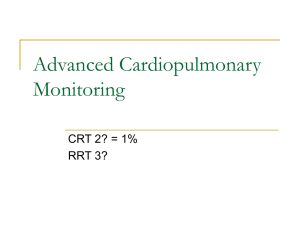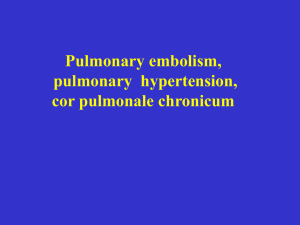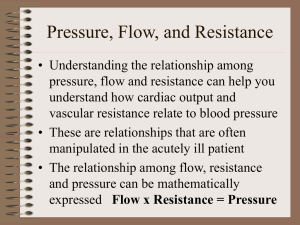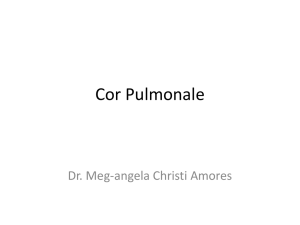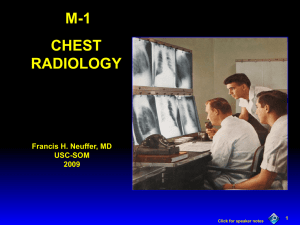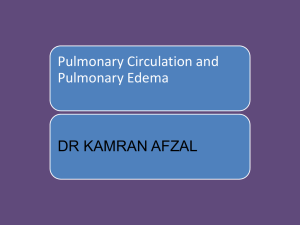Cardiac Monitoring and Cardiopulmonary Resuscitation Techniques
advertisement
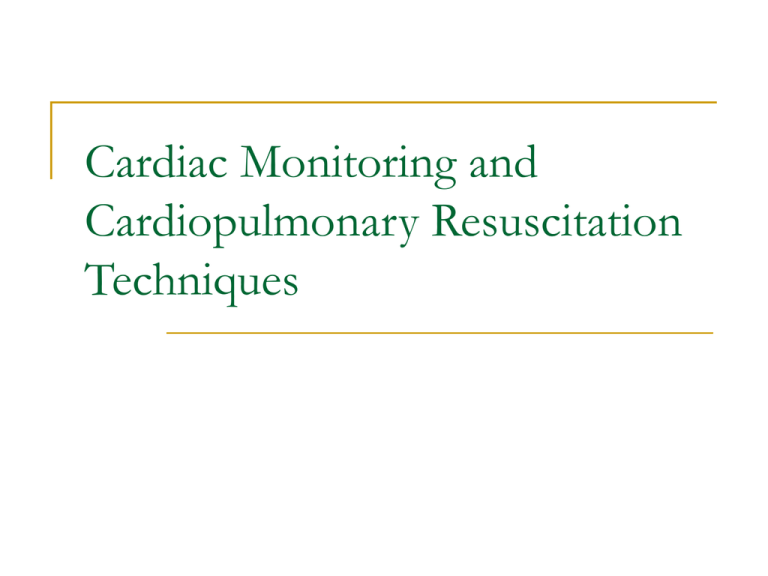
Cardiac Monitoring and Cardiopulmonary Resuscitation Techniques A normal sinus rhythm can be identified by: I. A resting rate of 60 to 100 beats/min in an adult II.A P wave before every QRS complex III.A regular rhythm IV.A QRS complex after every P wave V. A upright T wave in lead II A. II and IV B. II, III, and IV C. I, II, III, and V D.I, II, III, IV, and V A normal sinus rhythm can be identified by: I. A resting rate of 60 to 100 beats/min in an adult II.A P wave before every QRS complex III.A regular rhythm IV.A QRS complex after every P wave V. A upright T wave in lead II A. II and IV B. II, III, and IV C. I, II, III, and V D.I, II, III, IV, and V A patient with an acute myocardial infarction may have which of the following clinical findings? I. jaw pain II. Diaphoresis III. nausea and vomiting IV.digital clubbing A. I, II, and III only B. I, II, and IV only C. I, III, and IV only D. II, III, and IV only A patient with an acute myocardial infarction may have which of the following clinical findings? I. jaw pain II. Diaphoresis III. nausea and vomiting IV.digital clubbing A. I, II, and III only B. I, II, and IV only C. I, III, and IV only D. II, III, and IV only Electrocardiogram monitoring is important with an intensive care unit patient in all of the following situations except: A.If it is used to evaluate peripheral perfusion B.The patient has an electrolyte disturbance C.The patient has a history of arrhythmias D.The patient is being given a rapid infusion of potassium Electrocardiogram monitoring is important with an intensive care unit patient in all of the following situations except: A.If it is used to evaluate peripheral perfusion B.The patient has an electrolyte disturbance C.The patient has a history of arrhythmias D.The patient is being given a rapid infusion of potassium After attaching a cardiac monitor to a patient's chest, the respiratory therapist notes the ECG recording contains artifact. Which of the following could cause artifact in this situation? I. inadequate electrode contact II. improper electrode placement III. the patient scratching the electrodes IV.disconnected leads A. I and III only B. I and IV only C. II and III only D. II and IV only After attaching a cardiac monitor to a patient's chest, the respiratory therapist notes the ECG recording contains artifact. Which of the following could cause artifact in this situation? I. inadequate electrode contact II. improper electrode placement III. the patient scratching the electrodes IV.disconnected leads A. I and III only B. I and IV only C. II and III only D. II and IV only While assisting the physician using a synchronous defibrillator for cardioversion, the unit does not discharge. The respiratory therapist should check the I. charge level of the defibrillator. II. presence of a P wave. III. chest lead connections. IV.contact gel on the paddles. A. I, II, and III only B. I, II, and IV only C. I, III, and IV only D. II, III, and IV only While assisting the physician using a synchronous defibrillator for cardioversion, the unit does not discharge. The respiratory therapist should check the I. charge level of the defibrillator. II. presence of a P wave. III. chest lead connections. IV.contact gel on the paddles. A. I, II, and III only B. I, II, and IV only C. I, III, and IV only D. II, III, and IV only A 59-year-old patient is brought to the hospital with a complaint of sudden, severe substernal chest pain and dyspnea. What initial thing should the RRT recommend? A.Begin ECG monitoring B.Draw and ABG C.Get a CXR D.Get a capnometer sample A 59-year-old patient is brought to the hospital with a complaint of sudden, severe substernal chest pain and dyspnea. What initial thing should the RRT recommend? A.Begin ECG monitoring B.Draw and ABG C.Get a CXR D.Get a capnometer sample Defibrillation should be done immediately in which of the following patient situations? A.Second degree heart block B.Atrial flutter C.Pulseless ventricular tachycardia D.Sinus tachycardia Defibrillation should be done immediately in which of the following patient situations? A.Second degree heart block B.Atrial flutter C.Pulseless ventricular tachycardia D.Sinus tachycardia While performing CPR on a patient with chronic CO 2 retention, the resuscitation bag should be used A.without a reservoir and oxygen at 5 L/min. B.with a reservoir and an oxygen blender set at 40%. C.with a reservoir and oxygen at 15 L/min. D.without oxygen and a reservoir. While performing CPR on a patient with chronic CO 2 retention, the resuscitation bag should be used A.without a reservoir and oxygen at 5 L/min. B.with a reservoir and an oxygen blender set at 40%. C.with a reservoir and oxygen at 15 L/min. D.without oxygen and a reservoir. You are the RRT attending the delivery of a preterm neonate. His vital signs are: respiratory rate 12; heart rate 70. In addition, he has peripheral cyanosis and is responding minimally to stimulation. What should be done? A.Direct supplemental oxygen to his face B.Begin chest compressions C.Begin manual ventilation with 100% oxygen D.Continue to stimulate the newborn to breathe more deeply You are the RRT attending the delivery of a preterm neonate. His vital signs are: respiratory rate 12; heart rate 70. In addition, he has peripheral cyanosis and is responding minimally to stimulation. What should be done? A.Direct supplemental oxygen to his face B.Begin chest compressions C.Begin manual ventilation with 100% oxygen D.Continue to stimulate the newborn to breathe more deeply Pulmonary Artery Catheter: Waveform A 3-daypostoperative open-heart surgery patient has an arterial catheter in the right radial artery for continuous blood pressure measurements. Because of retained secretions, the respiratory therapist places him into a head down position for postural drainage therapy. The nurse notices that the patient’s blood pressure is less than before being placed into this new position. After the patient is returned to the original position, the blood pressure is the same as it was originally. How can the therapist explain the blood pressure changes? A. There was an air bubble in the arterial catheter B. There was a clot in the arterial catheter C. The patient’s body was below the level of the pressure transducer D. Postural drainage positions always cause the blood pressure to decrease A 3-daypostoperative open-heart surgery patient has an arterial catheter in the right radial artery for continuous blood pressure measurements. Because of retained secretions, the respiratory therapist places him into a head down position for postural drainage therapy. The nurse notices that the patient’s blood pressure is less than before being placed into this new position. After the patient is returned to the original position, the blood pressure is the same as it was originally. How can the therapist explain the blood pressure changes? A. There was an air bubble in the arterial catheter B. There was a clot in the arterial catheter C. The patient’s body was below the level of the pressure transducer D. Postural drainage positions always cause the blood pressure to decrease A patient with advanced emphysema is admitted to the respiratory intensive care unit. He is placed on a 24% Venturi-type mask and has a pulmonary artery catheter inserted. His initial pulmonary vascular resistance (PVR) is 300 dynes/sec/cm-5, and the PaO2 is 57 torr. The physician orders him increased to 28% oxygen. The resulting PVR is 220 dynes/sec/cm-5, and the PaO2 is 63 torr. Based on this information, what would you recommend? A. Decrease the oxygen to 24% B. Place the patient on a ventilator C.Administer a bronchodilator D.Keep the patient on 28% oxygen A patient with advanced emphysema is admitted to the respiratory intensive care unit. He is placed on a 24% Venturi-type mask and has a pulmonary artery catheter inserted. His initial pulmonary vascular resistance (PVR) is 300 dynes/sec/cm-5, and the PaO2 is 57 torr. The physician orders him increased to 28% oxygen. The resulting PVR is 220 dynes/sec/cm-5, and the PaO2 is 63 torr. Based on this information, what would you recommend? A. Decrease the oxygen to 24% B. Place the patient on a ventilator C.Administer a bronchodilator D.Keep the patient on 28% oxygen Capnography will be used to monitor a patient’s recovery from anesthesia. What gas should be used for the “zero” calibration? A.Room air for 0% carbon dioxide B.Room air for 21% oxygen C.5% carbon dioxide D.The same concentration of anesthetic gas as used with the patient Capnography will be used to monitor a patient’s recovery from anesthesia. What gas should be used for the “zero” calibration? A.Room air for 0% carbon dioxide B.Room air for 21% oxygen C.5% carbon dioxide D.The same concentration of anesthetic gas as used with the patient Your patient is in the intensive care unit and is being monitored with a pulmonary artery catheter. She has the following parameters: PAP 35/20 mmHg; PCWP 9 mmHg; CVP 10 mmHg. You would interpret the data to indicate that she: A.Has right ventricular failure/ cor pulmonale B.Has left ventricular failure C.Has increased pulmonary vascular resistance D.Is hypovolemic Your patient is in the intensive care unit and is being monitored with a pulmonary artery catheter. She has the following parameters: PAP 35/20 mmHg; PCWP 9 mmHg; CVP 10 mmHg. You would interpret the data to indicate that she: A.Has right ventricular failure/ cor pulmonale B.Has left ventricular failure C.Has increased pulmonary vascular resistance D.Is hypovolemic A 40-year old patient receiving mechanical ventilation has an arterial line in place. It is noticed that a significant difference exists between the blood pressure taken by cuff on the left arm and the blood pressure taken by arterial line on the right arm. What could explain this difference? I. A clot is at the tip of the catheter II. There is an air bubble in the arterial line III.The ventilator’s peak pressure is too high IV.The patient has a ventricular septal defect A. I and II B. II and III C. I, III, and IV D. I, II, III, and IV A 40-year old patient receiving mechanical ventilation has an arterial line in place. It is noticed that a significant difference exists between the blood pressure taken by cuff on the left arm and the blood pressure taken by arterial line on the right arm. What could explain this difference? I. A clot is at the tip of the catheter II. There is an air bubble in the arterial line III.The ventilator’s peak pressure is too high IV.The patient has a ventricular septal defect A. I and II B. II and III C. I, III, and IV D. I, II, III, and IV An adult patient is receiving mechanical ventilation when the following data are gathered: 9:00 am 11:00 am PaO2 75 53 mmHg PVR 120 340 dynes/sec/cm-5 PCWP 8 10 mmHg PAP 25/10 42/21 mmHg How should the results be interpreted A.Pulmonary edema B.Pulmonary embolism C.Pneumonia D.Cardiac tamponade An adult patient is receiving mechanical ventilation when the following data are gathered: 9:00 am 11:00 am PaO2 75 53 mmHg PVR 120 340 dynes/sec/cm-5 PCWP 8 10 mmHg PAP 25/10 42/21 mmHg How should the results be interpreted A.Pulmonary edema B.Pulmonary embolism C.Pneumonia D.Cardiac tamponade A 35-year-old patient in the intensive care unit has the following hemodynamic data. Which of them indicates a problem with the patient? A. SVR of 600 dynes/sec/cm-5 B. CI of 3 L/min/m2 C. PvO2 of 38 torr D. Shunt of 4% A 35-year-old patient in the intensive care unit has the following hemodynamic data. Which of them indicates a problem with the patient? A. SVR of 600 dynes/sec/cm-5 B. CI of 3 L/min/m2 C. PvO2 of 38 torr D. Shunt of 4% An unconscious 25-year-old patient is admitted with viral pneumonia, vomiting, and diarrhea. Mechanical ventilation is initiated, and flowdirected pulmonary artery (Swan-Ganz) catheter is inserted. The following data are gathered: Pulmonary artery pressure, 22/8 mm Hg; Pulmonary capillary wedge pressure, 3 mm Hg; Central venous pressure, 0 mm Hg; blood pressure, 90/60 mm Hg; Pulse, 142/min. What is the most likely cause of these findings? • Hypovolemia • High ventilating pressures • Bronchospasm • Rupture of the balloon on the catheter An unconscious 25-year-old patient is admitted with viral pneumonia, vomiting, and diarrhea. Mechanical ventilation is initiated, and flowdirected pulmonary artery (Swan-Ganz) catheter is inserted. The following data are gathered: Pulmonary artery pressure, 22/8 mm Hg; Pulmonary capillary wedge pressure, 3 mm Hg; Central venous pressure, 0 mm Hg; blood pressure, 90/60 mm Hg; Pulse, 142/min. What is the most likely cause of these findings? • Hypovolemia • High ventilating pressures • Bronchospasm • Rupture of the balloon on the catheter Which of the following clinical observations is most commonly associated with right heart failure? A. peripheral edema B. muscle wasting C. tracheal deviation D. skin flushing Which of the following clinical observations is most commonly associated with right heart failure? A. peripheral edema B. muscle wasting C. tracheal deviation D. skin flushing While assisting the physician using a synchronous defibrillator for cardioversion, the unit does not discharge. The respiratory therapist should check the I. charge level of the defibrillator. II. presence of a P wave. III. chest lead connections. IV. contact gel on the paddles. A. I, II, and III only B. I, II, and IV only C. I, III, and IV only D. II, III, and IV only While assisting the physician using a synchronous defibrillator for cardioversion, the unit does not discharge. The respiratory therapist should check the I. charge level of the defibrillator. II. presence of a P wave. III. chest lead connections. IV. contact gel on the paddles. A. I, II, and III only B. I, II, and IV only C. I, III, and IV only D. II, III, and IV only A patient's chest radiograph shows diffuse alveolar infiltrates. The following data are available: Which of the following should be used to differentiate between cardiac and noncardiac etiology for these results? A. right atrial pressure B. central venous pressure C. mean pulmonary artery pressure D. pulmonary capillary wedge pressure A patient's chest radiograph shows diffuse alveolar infiltrates. The following data are available: Which of the following should be used to differentiate between cardiac and noncardiac etiology for these results? A. right atrial pressure B. central venous pressure C. mean pulmonary artery pressure D. pulmonary capillary wedge pressure A patient with an acute myocardial infarction may have which of the following clinical findings? I. jaw pain II. diaphoresis III. nausea and vomiting IV. digital clubbing A. I, II, and III only B. I, II, and IV only C. I, III, and IV only D. II, III, and IV only A patient with an acute myocardial infarction may have which of the following clinical findings? I. jaw pain II. diaphoresis III. nausea and vomiting IV. digital clubbing A. I, II, and III only B. I, II, and IV only C. I, III, and IV only D. II, III, and IV only After attaching a cardiac monitor to a patient's chest, the respiratory therapist notes the ECG recording contains artifact. Which of the following could cause artifact in this situation? I. inadequate electrode contact II. improper electrode placement III. the patient scratching the electrodes IV. disconnected leads A. I and III only B. I and IV only C. II and III only D. II and IV only After attaching a cardiac monitor to a patient's chest, the respiratory therapist notes the ECG recording contains artifact. Which of the following could cause artifact in this situation? I. inadequate electrode contact II. improper electrode placement III. the patient scratching the electrodes IV. disconnected leads A. I and III only B. I and IV only C. II and III only D. II and IV only A patient hospitalized with a deep-vein thrombosis in the leg experiences sudden shortness of breath. Which of the following should be recommended to evaluate the patient’s situation? • Lung compliance • Electrocardiogram • Chest radiograph • VD/VT A patient hospitalized with a deep-vein thrombosis in the leg experiences sudden shortness of breath. Which of the following should be recommended to evaluate the patient’s situation? • Lung compliance • Electrocardiogram • Chest radiograph • VD/VT The End
